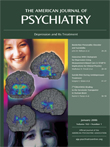Benefits of Light Treatment for Depression
To the Editor: It is gratifying that the APA Committee on Research on Psychiatric Treatments (in a report by Robert N. Golden, M.D., et al. [1]) concluded that light therapy is beneficial and that effect sizes are comparable to those found in antidepressant drug trials.
A similar conclusion on the effects of bright light was reached in our Cochrane review of light treatment of nonseasonal depression (2). There are many complexities in deciding which studies to include in meta-analyses. The Cochrane review used extensive search strategies to retrieve all relevant randomized studies and included many more randomized studies of light treatment for nonseasonal depression than the recent meta-analysis by Dr. Golden et al. (1). Differing from the conclusion of Dr. Golden et al., the Cochrane review found a slightly greater benefit of light therapy in studies of subjects receiving concomitant drug treatment than among those who were drug free. The recent large study of Martiny (3) added new evidence for the adjunctive use of bright light. A forthcoming update of our systematic Cochrane review (unpublished) will include this and other new studies on the topic.
The analysis of Dr. Golden et al. questioning the effectiveness of adjunctive light treatment for nonseasonal depression may have included some minor errors. The two least-positive reports that were included (their references 25 and 26) used the same study twice. Also, the two less encouraging studies included for drug-free treatment of nonseasonal depression appear to have used the same study twice (their references 16 and 18). An erroneous negative impression of light treatment may have arisen from the nine publications of the nonsignificant contrasts with control observed in these two studies counted twice, whereas most positive-outcome studies were published in only one place.
The APA Committee on Research on Psychiatric Treatments pointed out correctly that many studies of bright light have been small and have not received the financial backing that has been devoted to clinical trials of antidepressant drugs. There is already some evidence to endorse the use of bright light treatment for nonseasonal depression, but further studies evaluating the use of bright light treatment as an adjunct to pharmacotherapy are clearly needed. Neither bright light nor pharmacotherapy for depression produces a high enough remission rate, so the combination would improve our therapeutic approach. If we are to better understand the optimal doses of bright light and the circumstances in which it is beneficial, a number of larger-scale multicenter trials must be supported.
1. Golden RN, Gaynes BN, Ekstrom RD, Hamer RM, Jacobsen FM, Suppes T, Wisner KL, Nemeroff CB: The efficacy of light therapy in the treatment of mood disorders: a review and meta-analysis of the evidence. Am J Psychiatry 2005; 162:656–662Link, Google Scholar
2. Tuunainen A, Kripke DF, Endo T: Light therapy for non-seasonal depression. Cochrane Database Syst Rev 2004;(2):CD004050Google Scholar
3. Martiny K: Adjunctive bright light in non-seasonal major depression. Acta Psychiatr Scand 2004; 110:7–28Crossref, Google Scholar



